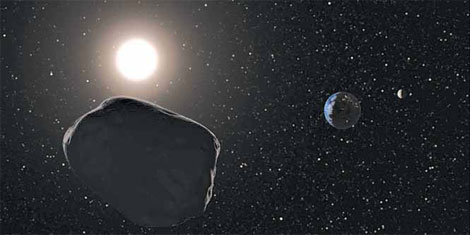Pursuing precious metals in the asteroid belt
Updated: 2012-05-06 07:43
By Kenneth Chang(The New York Times)
|
|||||||
|
A company called Planetary Resources plans to mine asteroids that are relatively close to Earth using robotic spacecraft. Planetary Resources |
Perhaps it will be a platinum rush that finally opens up the final frontier.
A company called Planetary Resources has announced plans to mine asteroids that zip close by Earth, both to provide supplies for future interplanetary travelers and to bring back precious metals like platinum.
The venture may sound far-fetched, but it has attracted some big-name investors, including Larry Page and Eric Schmidt of Google, as well as profitable technology development contracts.
"If you believe that resources in space are critical towards a space-faring future, you will inevitably come to the result that the asteroids - in fact, the near-Earth asteroids - are the steppingstones to the rest of the solar system," said Eric C. Anderson, one of the company's co-founders.
Because an asteroid is devoid of air and its gravitational pull is negligible, getting there is relatively easy. Unlike landing on the Moon or Mars, a robotic mining spacecraft would not need parachutes or a large engine to fly up to and attach itself to a small asteroid.
"There are probably about 1,500 near-Earth asteroids that are energetically easier to reach than the surface of the Moon," Mr. Anderson said.
Some of the asteroids are icy - up to 20 percent water - and the water could be drawn out by melting the ice. The water could be taken to supply stopovers for future astronauts or broken down into breathable oxygen or propellant for spacecraft on interplanetary missions.
Other asteroids are rocky and metallic. Robotic mining spacecraft could grind up pieces of the asteroid and smelt it to capture precious metals within.
Platinum - which is used for jewelry, electronics components and automobile catalytic converters - currently fetches about $1,500 an ounce, so a spacecraft would not have to bring back a lot of it for the enterprise to make money. More common metals like iron could perhaps be used as raw materials in space factories, churning out spacecraft and other structures.
Mr. Anderson and Peter H. Diamandis, the other founder of Planetary Resources, are already in the space tourism business with a company called Space Adventures, which has arranged eight trips to the International Space Station. While that venture has been a "reasonably good success story," Mr. Diamandis said, "the realization, at least for us, was it wasn't on track to really drive humanity opening the space frontier at the level that we desire."
The president and chief engineer of Planetary Resources is Christopher A. Lewicki, who previously worked as a manager on Mars missions at NASA's Jet Propulsion Laboratory. Based in Bellevue, Washington, the company employs 25 engineers and has development contracts for technologies like laser communications that it believes it will need for prospecting and mining missions.
The plan is to launch the first spacecraft - a small telescope to find small nearby asteroids - within the next two years. Next, the company would send out a batch of small explorers to visit some of the asteroids. Mining would follow, first targeting water and then platinum.
One possibility the company is considering is to nudge a small asteroid, perhaps one about 91 meters long, into an orbit around Earth closer than the Moon. From meteorites that have landed on Earth, scientists know that some asteroids have concentrations of platinum 20 times that of ore in a platinum mine on Earth. The company would need to develop robotic technology to extract the element from the rocks.
"To do large, large-scale mining of asteroids, you're talking about decades," Mr. Anderson said.
The New York Times
(China Daily 05/06/2012 page11)
